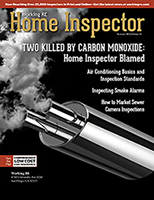 | > E&O/GL Insurance for Home Inspectors Competitive Rates, Broad Coverage, Free Risk Management, online inspection support for tough questions, discounts on education and more... Professional Coverage, Competitive Pricing Shop OREP today! |
>> Editor’s Note: To help you stay up-to-date and connected, OREP/Working RE has established a Coronavirus (COVID-19) Discussion and Resource Page where you can share your thoughts, experiences, advice and challenges with fellow inspectors. See what Inspectors are saying here!
“In 2020, local fire departments responded to an estimated 1.4 million fires in the United States alone. These fires caused 3,500 civilian fire deaths and 15,200 reported civilian fire injuries according to the National Fire Protection Association.”
Inspecting Smoke Alarms
By Rick Bunzel
In January, a tragic fire occurred in Philadelphia, killing 12 people and injuring several more. As a retired firefighter, my first thought was: “why was there such a great a loss of life and secondly, were there working smoke alarms?” Unfortunately, the Philadelphia Fire Department found six inoperable and/or disabled smoke alarms in the unit in which the fire occurred.
The Philadelphia Housing Authority (PHA) inspected the two units in April 2021 and May 2021. All smoke alarms were operating properly at those times, according to PHA representatives. It’s unclear why the occupants disabled the smoke alarms, but what is clear is that the fire happened very quickly and the occupants could not escape in time.
Most homeowners don’t realize that home décor is highly flammable. Furniture and décor are typically made with petro-chemical materials that burn faster and release toxic smoke. According to Consumer Safety Director, John Drengenberg of Underwriters Laboratories (UL), “Thirty years ago, you had on average about 14 to 17 minutes to escape a house fire.” Drengenberg continues, “Today, with the prevalence of synthetic materials in the home, occupants have roughly 2 to 3 minutes to get out.“
In 2020, local fire departments responded to an estimated 1.4 million fires in the United States alone. These fires caused 3,500 civilian fire deaths and 15,200 reported civilian fire injuries according to the National Fire Protection Association.
So why did the occupants of the Philadelphia fire disable their six smoke alarms? The most frequent reason I come across, is that the smoke alarms were being nuisance tripped. Many times, they are installed too close to a kitchen or bathroom and the odors or steam produce a false alarm. If that happens on a regular basis the occupants will “fix” the problem by disabling the alarm. The second reason could be not replacing the battery. Smoke alarms are designed to give a low battery warning which typically happens at night. Most occupants will silence the warning by removing the battery. However, once the alarm is silenced they forget about replacing the battery.
Manufacturers are slowly introducing new technology and changes to the smoke alarms to address these issues. First Alert and Kidde are producing Lifetime or 10 Year Worry-Free alarms.
(story continues below)

These units are sealed and have a lithium battery that is rated for 10 years. At the end of 10 years the entire unit gets replaced. The manufacturers are bringing down the cost of dual sensor detectors. Dual sensor alarms are supposed to respond faster and not be as sensitive to cooking odors.
Nest is driving the market in building smart alarms. Many of the manufacturers are working on adding artificial intelligence to their products. Smart alarms will link to your phone and will have the ability give you more information. Today’s smoke alarms have one type of alarm, but what if the alarm could tell you where in the home the alarm was sensing an issue and what it was sensing? The hope is that the homeowner will have more information on the alarm and be able to take appropriate action instead of just resetting the alarm.
In the mid-2000’s there was a controversy over which type of smoke alarm is superior and the American Society of Home Inspectors (ASHI) endorsed having photoelectric smoke alarms only. There were several videos showing a fish bowl test of the alarms to demonstrate. I decided to talk to my local fire marshal and research the issues on my own time. I found that numerous organizations: the National Fire Protection Association (NFPA), U.S. Fire Administration (USFA), National Institute of Standards and Technology (NIST), Consumer Products Safety Commission (CPSC), National Association of State Fire Marshals (NASFM) and Underwriters Laboratories (UL) reviewed the issue and came to the same basic conclusion. Both technologies work and the speed in their response depends on what’s burning. Since then, the organizations all recommend a combination of ionization and photoelectric smoke alarms in every home.
From my home inspector point of view, I really don’t care which type a home has as long as they are working and they have them in the appropriate locations.
Inspecting Smoke Alarms
I constantly see smoke alarms that are older than 20 years or even find the bracket that once held a smoke alarm. I’ve seen where smoke alarms are located improperly such as in a kitchen or adjacent to a bathroom. These locations are just wrong and lead to false alarms. Many occupants will just remove or disable alarms that false constantly.
I don’t actually test smoke alarms with the test button. I will make sure they have power via the LED and I may verify that they are interconnected. The test button only confirms that the battery, electronics, and alert system are working. It doesn’t mean that the smoke sensor is working. The only way to test that is with “canned smoke.”
When I was a newbie, I bought one smoke can but most of my clients really didn’t care. So now I confirm the smoke alarms’ presence, location, and age. The easiest and quickest way to gauge the age is by looking at the detector color. If the detector shell is no longer white and turned golden beige, most likely it’s older than 10 years or is getting to that point. If the detector is white but the home is in the 10-to-15-year range, then most likely the detectors are original and should be changed. Many units will have a date on the unit label, which will need removing with a half turn to take a look. If the homeowner painted the smoke alarm, then it’s an automatic fail as the paint will compromise the sensors.
Home inspectors can save lives by educating clients on this piece of safety equipment and verify the proper installation. Imagine if the rowhouse in Philadelphia had six working smoke alarms? At 6:30 in the morning I am pretty sure they would have had time to evacuate the home and be standing on the street when the fire department arrived.
About the Author
Rick Bunzel is the principle inspector with Pacific Crest Inspections and an ASHI Certified Inspector #249557. He holds a BA in Business Marketing and in the past, he chaired the marketing and public relations committees for a national home inspection organization. Locally, he is active in the North Puget Sound Board of Realtor’s and recently retired from the Mt. Erie Fire Department in Anacortes, WA. http://www.paccrestinspections.com.
OREP/WRE Coronavirus Discussion and Resource Page
Coronavirus: National Home Inspector Survey
Real-Life Inspector Lawsuits and How to Protect Yourself
Available Now
Presenter: Isaac Peck, President of OREP
Isaac Peck, President of OREP Insurance Services, shares his insights and advice gained over nearly 10 years of providing risk management and E&O insurance for home inspectors. You will not hear many of these insights anywhere else.
Watch Now!
Send your story submission/idea to the Editor:
isaac@orep.org
Note: The Summer 2022 Working RE Home Inspector is now mailing to over 25,000 home inspectors nationwide. OREP Insureds/members enjoy guaranteed delivery of each print magazine and many more benefits.


